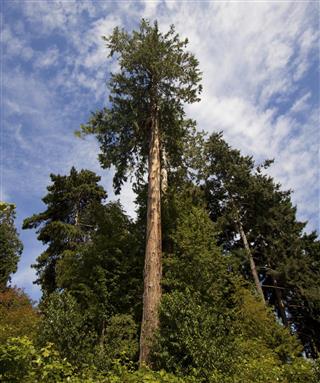
The western red cedar tree is a native of North America and is known as a perennial tree. The following article will cover the information about this tree that will help you learn more about it.
You may have observed a giant tree that is up to 60 meters tall, has drooping branches, and a trunk that spreads out widely at the base. If this is the case, you may have encountered a western red cedar, which is a member if Cupressaceae family. The scientific name of this species is Thuja plicata. The following article will give you some more interesting information about this tree that will be useful for you.
Habitat
The western red cedar is a native of north-western North America. The habitat of this species also covers the southern Alaska and British Columbia. These trees are commonly found in the south to north-west California and western Montana. This tree is found growing at an elevation of about 4495 feet above sea level, and is found to flourish in lush forests and on mountainsides. Being a riparian tree, it also grows around swamps and stream banks. It can grow and reproduce under dense shade, as it is shade-tolerant.
Seeds
The seeds are contained in cones that are ellipsoid in shape. These seed cones are about 0.4 inches long and are shaped like an egg. It has many pairs of scales, and the pollen cones are reddish in color. There are about 8 to 14 seeds per cone and they have lateral wings.
Leaves
The leaves of a western red cedar are like scales. These grow in opposite pairs in four rows. One pair is folded while the other is not. Because of this, they look like overlapping shingles. The leaves are arranged on flat, fan-like sprays on a twig. The leaves have a very strong spicy aroma and are evergreen. They are glossy green on the upper side and white striped on the lower side.
Bark
The bark of this tree is gray in color. It is stringy in nature and can tear off in long strips on the mature trees.
Height
A western red cedar can reach about 40 to 150 feet in height and about 22 feet in diameter at the trunk. It develops a crown that reaches the ground. This tree can live for more than 1000 years.
Planting
You need to plant the western red cedars at a 20 to 30 feet distance from one another. Plant the tree in a spot that receives full sun, i.e., an area that receives 6 or more hours of continuous sunlight. The tree grows well in soil with a pH between 5.5 to 8.5.
Dig a hole that is as wide as the root ball and as deep as the container containing the root ball. Place the sapling in the center and backfill with soil. You should make a watering ring around the perimeter of the planting hole to ensure that the water is directed to the roots on the outside. You should water the tree well, with at least an inch of water once every week. Mulch with three inches of compost or pulverized bark.
Care
It is advisable to water the tree deeply once a week rather than shallow and frequent watering. The western red cedar does not require to be fertilized very often. During the first year of growing of the tree, feed it with a phosphorous-based fertilizer to encourage root growth. Then, feed the tree with a fertilizer once every three years. If the soil is poor in nutrients, then add a nutrient-based fertilizer to the soil, instead of an all-around fertilizer.
These trees are sturdy and can grow under harsh conditions. These evergreen trees have tightly-packed leaves that attract deer during winter, so take care that the leaves are not excessively grazed, as the tree may die. Taking care of this tree also includes caring for its bark. Due to its fibrous string nature, the bark is used for weaving. But, excessive stripping of the bark will kill the tree. Therefore, do not indulge in stripping the barks out.
Facts
- The western red cedar is also known as the giant arborvitae, western arborvitae, giant red cedar, Pacific red cedar, and canoe cedar. It is also known as shinglewood.
- This tree has the distinction of being the official tree of the British Columbia.
- The western red cedar was known as the Tree of Life by the Native Americans.
- The seed cones of this tree are bent backwards along the branches.
- The dropping branches of this tree turn up at the tip.
- The western red cedar can grow in cold, mild, and moist locations and also in shaded areas that have a nutrient-rich soil.
- The western red cedar can grow over 60 meters in height.
- The wood of this tree is resistant to decay and damage by insects.
- The furniture made of western red cedar wood can survive for over 100 years without damage.
- A few western red cedars found on Queen Charlotte islands are known to be over 900 years old.
- In 1972, vandals set fire to and destroyed a 240 feet tall and over 800 years old western red cedar in Cathedral Groove on Vancouver Island.
- The wood of this tree is used to make interior paneling, outdoor furniture, mats, clothing, baskets, fishing lines, medicines, religious masks, decking, fencing, etc.
A western red cedar is one sturdy and strong tree that will remain in your backyard for a long, long time. It is also used for many purposes and helps make long-lasting furniture. The next time you take a walk in the woods, make sure you spend a few moments admiring this gentle giant.


